
Back هجوم بودابست Arabic Будапещенска операция Bulgarian حمله بوداپست Persian Offensive de Budapest French מתקפת בודפשט HE Budimpeštanska ofenziva Croatian Կարմիր բանակի ներխուժումը Բուդապեշտ Armenian Serangan Budapest ID ブダペスト攻勢 Japanese Operacja budapesztańska Polish
| Budapest offensive | |||||||
|---|---|---|---|---|---|---|---|
| Part of the Eastern Front of World War II | |||||||
 Soviet IS-2 tank in action (Battle of Budapest) | |||||||
| |||||||
| Belligerents | |||||||
|
|
| ||||||
| Commanders and leaders | |||||||
|
|
| ||||||
| Units involved | |||||||
| Casualties and losses | |||||||
|
Soviet: 80,026 dead and missing 240,056 wounded and sick Total casualties: 320,082 (including 260,000 combat casualties) 1,766 tanks destroyed 4,127 guns and mortars 293 aircraft 135,100 small arms[1][2][3] |
Siege of Budapest: 125,000 combat casualties[1] (48,000 killed, 26,000 wounded, 51,000 captured) Total: ~270,000 combat casualties | ||||||
|
76,000 civilian dead[4] 38,000 civilians dead in the siege (7,000 executed) 38,000 died in labour or POW camps | |||||||
The Budapest offensive was the general attack by Soviet and Romanian armies against Hungary and their Axis allies from Nazi Germany. The offensive lasted from 29 October 1944 until the fall of Budapest on 13 February 1945. This was one of the most difficult and complicated offensives that the Soviet Army carried out in Central Europe. It resulted in a decisive victory for the USSR, as it greatly sped up the ending of World War II in Europe.[5]
- ^ a b Frieser et al. 2007, p. 922.
- ^ Glantz, David M., and Jonathan House. When Titans Clashed: How the Red Army Stopped Hitler. (Lawrence, Kansas: University Press of Kansas, 1995. ISBN 0-7006-0899-0) p. 298
- ^ Krivosheev, G. F. Soviet casualties and combat losses in the Twentieth Century. (London: Greenhill Books, 1997. ISBN 1-85367-280-7) p. 152
- ^ Ungváry 2003, p. 330.
- ^ Самсонов, Александр Михайлович Крах фашистской агрессии 1939-1945. — М.: Наука, 1980. (in Russian)